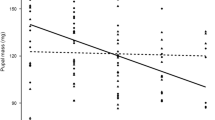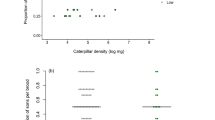Abstract
Fisher's theoretical prediction of equal investment in each sex for a panmictic population (The genetical theory of natural selection. Clarendon, Oxford, 1930) can be altered by a number of factors. For example, the sex ratio theory predicts variation in equal investment in each sex when the maternal fitness gains from increased investment differ between sexes. Changing sex allocation because of changing payoffs may result from different ecological situations, such as foraging conditions. We investigated the impact of foraging travel cost on relative investment in sons vs daughters. Field studies were carried out with the central-place-foraging leafcutter bee Megachile rotundata (Fabricius), which has smaller males than females. Therefore, less investment is required to produce a viable son compared with a daughter. We found that with increased flight distance to resources, females produced a greater proportion of sons. Females also invested fewer resources in individual sons and daughters and produced fewer offspring with increased flight distance.


Similar content being viewed by others
References
Alcock J (1979) The relation between female body size and provisioning behavior in the bee Centris pallida Fox (Hymenoptera: Anthophoridae). J Kans Entomol Soc 52:623–632
Anderson DJ, Reeve J, Martinez Gomez JE, Weathers WW, Hutson S, Cunningham HV, Bird DM (1993) Sexual size dimorphism and food requirements of nestling birds. Can J Zool 71:2541–2545
Barthell JF, Thorp RW (1995) Nest usurpation among females of an introduced leafcutter bee, Megachile apicalis. Southwest Entomol 20:117–124
Bortolotti GR (1986) Influence of sibling competition on nestling sex ratios of sexually dimorphic birds. Am Nat 127:495–507
Bosch J, Kemp WP (2004) Effect of pre-wintering and wintering temperature regimes on weight loss, survival, and emergence time in the mason bee Osmia cornuta (Hymenoptera: Megachilidae). Apidologie 35:469–479
Bosch J, Vicens N (2002) Body size as an estimator of production costs in a solitary bee. Ecol Entomol 27:129–137
Boulet M, Olsen P, Cockburn A, Newgrain K (2001) Parental investment in male and female offspring by the peregrine falcon, Falco peregrinus. EMU 101:95–103
Campbell DR (2000) Experimental tests of sex-allocation theory in plants. TREE 15:227–232
Charnov EL (1982) The theory of sex allocation. Princeton University Press, Princeton
Charnov EL, Bull J (1977) When is sex environmentally determined. Nature 266:828–830
Charnov EL, Los-den Hartogh RL, Jones WT, van den Assem J (1981) Sex ratio evolution in a variable environment. Nature 289:27–33
Clark AB (1978) Sex ratio and local resource competition in a prosimian primate. Science 201:163–165
Clutton-Brock TH, Albon SD, Guinness FE (1984) Maternal dominance, breeding success and birth sex ratios in red deer. Nature 308:358–360
Cowan DP (1981) Parental investment in two solitary wasps Ancistrocerus adiabatus and Euodynerus foraminatus (Eumenidae: Hymenoptera). Behav Ecol Sociobiol 9:95–102
Dyrcz A, Sauer-Gürth H, Tkadlec E, Wink M (2004) Offspring sex ratio variation in relation to brood size and mortality in a promiscuous species: the aquatic warbler Acrocephalus paludicola. Ibis 146:269–280
Fisher RA (1930) The genetical theory of natural selection. Clarendon, Oxford
Frank SA (1990) Sex allocation theory for birds and mammals. Ann Rev Ecolog Syst 21:13–55
Frank SA (1995) Sex allocation in solitary bees and wasps. Am Nat 146:316–323
Freeman BE (1981a) Parental investment and its ecological consequences on the solitary wasp Sceliphron assimile (Dahlbom) (Sphecidae). Behav Ecol Sociobiol 9:261–268
Freeman BE (1981b) Parental investment, maternal size and population dynamics of a solitary wasp. Am Nat 117:357–362
Frohlich DR, Tepedino VJ (1986) Sex ratio, parental investment, and interparent variability in nesting success in a solitary bee. Evolution 40:142–151
Gerber HS, Klostermeyer EC (1970) Factors affecting the sex ratio and nesting behaviour of the alfalfa leafcutter bee. Technical Bulletin No. 73: Washington Agricultural Experiment Station, Washington, DC
Hamilton WD (1964) The genetical evolution of social behaviour. J Theor Biol 7:1–52
Hamilton WD (1967) Extraordinary sex ratios. Science 156:477–488
Hamilton WD (1979) Wingless and flightless males in fig wasps and other insects. In: Blum MS, Blum NA (eds) Sexual selection and reproductive competition in insects, Academic, New York, pp 167–220
Hardy ICW (2002) Sex ratios: concepts and research methods. Cambridge University Press, Cambridge
Helms KR (1994) Sexual size dimorphism and sex ratios in bees and wasps. Am Nat 143:418–434
Jay SC, Mohr N (1987) The effect of nest replacement on the production of females of the alfalfa leaf-cutter bee Megachile rotundata. J Apic Res 26:69–72
Johnson MD (1988) The relationship of provision weight to adult weight and sex ratio in the solitary bee Ceratina calcarata. Ecol Entomol 13:165–170
Kim J-Y (1997) Female size and fitness in the leaf-cutter bee Megachile apicalis. Ecol Entomol 22:275–282
Kim J-Y (1999) Influence of resource level on maternal investment in a leaf-cutter bee (Hymenoptera: Megachilidae). Behav Ecol 10:552–556
Klostermeyer EC, Mech SJ Jr, Rasmussen WB (1973) Sex and weight of Megachile rotundata (Hymenoptera: Megachilidae) progeny associated with provision weights. J Kans Entomol Soc 46:536–548
Komdeur J, Daan S, Tinbergen J, Mateman C (1997) Extreme adaptive modification in sex ratio of the Seychelles Warbler's eggs. Nature 385:522–525
Korpimäki E, May CA, Parkin DT, Wetton JH, Wiehn J (2000) Environmental and parental condition-related variation in sex ratio of kestrel broods. J Avian Biol 31:128–134
Koskela E, Huitu O, Koivula M, Korpimaki E, Mappes T (2004) Sex-biased maternal investment in voles: importance of environmental conditions. Proc R Soc Lond B 271:1385–1391 30
Krunic MD (1971) Mating of the alfalfa leafcutter bee, Megachile rotundata (F.), in the laboratory. Can J Zool 49:778–779
Kruuk LEB, Clutton-Brock TH, Albon SD, Pemberton JM, Guinness FE (1999) Population density affects sex ratio variation in red deer. Nature 399:459–461
Larsson FK (1990) Female body size relationships with fecundity and egg size in two solitary species of fossorial Hymenoptera (Colletidae and Sphecidae). Entomol Gen 15:167–171
Maki DL, Moffett JO (1986) Nesting cell position, sex ratios, and emergence times of the alfalfa leafcutting bee, Megachile rotundata (F) in northwest Oklahoma. Southwest Entomol 11:107–112
McCorquodale DB, Owen RE (1997) Allozyme variation, relatedness among progeny in a nest, and sex ratio in the leafcutter bee, Megachile rotundata (Fabricius) (Hymenptera: Megachilidae). Can Entomol 129:211–219
Minckley RL, Wcislo WT, Yanega D (1994) Behavior and phenology of a specialist bee (Dieunomia) and sunflower (Helianthus) pollen availability. Ecology 75:1406–1419
Oddie K (1998) Sex discrimination before birth. TREE 13:130–131
Orians GH, Pearson NE (1979) On the theory of central place foraging. In: Horn DJ, Mitchell RD, Stairs GR (eds) Analysis of ecological systems. Ohio State University Press, Columbus, OH, pp 155–177
Pankiw P, Siemens B (1974) Management of Megachile rotundata in northwestern Canada for population increase. Can Entomol 106:1003–1008
Peterson SS, Baird CR, Bitner RM (1992) Current status of the alfalfa leafcutting bee, Megachile rotundata, as a pollinator of alfalfa seed. Bee Sci 2:135–142
Phillips JK, Klostermeyer EC (1978) Nesting behavior of Osmia lignaria propinqua (Hymenoptera: Megachilidae). J Kans Entomol Soc 51:91–108
Richards KW (1994) Ovarian development in the alfalfa leafcutter bee, Megachile rotundata. J Apic Res 33:199–203
Rosenberg DK, McKelvey KS (1999) Estimation of habitat selection for central-place foraging animals. J Wildl Manage 63:1028–1038
Rosenheim JA, Nonacs P, Mangel M (1996) Sex ratios and multifaceted parental investment. Am Nat 148:501–535
Schoener TW (1979) Generality of the size–distance relation in models of optimal foraging. Am Nat 114:902–914
Schwarz MP (1988) Local resource enhancement and sex ratios in a primitively social bee. Nature 331:346–348
Sheldon BC, Andersson S, Griffith SC, Örnborg J, Sendecka J (1999) Ultraviolet colour variation influences blue tit sex ratios. Nature 402:874–877
Smith CC, Fretwell SD (1974) The optimal balance between size and number of offspring. Am Nat 108:499–506
Stearns SC (1992) The evolution of life history strategies. Oxford University Press, Oxford
Stephens DW, Krebs JR (1986) Foraging theory. Princeton University Press, Princeton
Strohm E, Linsenmair KE (1999) Measurement of parental investment and sex allocation in the European beewolf Philanthus triangulum F. (Hymenoptera: Sphecidae). Behav Ecol Sociobiol 47:76–88
Sugiura N, Maeta Y (1989) Parental investment and offspring sex ratio in a solitary Mason bee, Osmia cornifrons (Radoszkowski) (Hymenoptera, Megachilidae). Jpn J Entomol 57:861–875
Tasei JN, Delaude A (1984) Efficacité pollinisatrice de Megachile rotundata F. (Hymenoptera: Megachilidae) utilisée sur luzerne Medicago sativa L. Agronomie 4:653–662
Tepedino VJ, Parker FD (1986) Effect of rearing temperature on mortality second-generation emergence and size of adult in Megachile rotundata (Hymenoptera: Megachilidae). J Econ Entomol 79:974–977
Tepedino VJ, Torchio PF (1982) Phenotypic variability in nesting success among Osmia lignaria propinqua females in a glasshouse environment (Hymenoptera: Megachilidae). Ecol Entomol 7:453–462
Tepedino VJ, Thompson R, Torchio PF (1984) Heritability for size in the megachilid bee Osimia lignaria propinqua Cresson. Apidologie 15:83–88
Tepedino VJ, Frohlich DR, Baird CR (1994) Effect of intertunnel distance and nest surface aspect on progeny production rate and sex ratio in the alfalfa leafcutting bee (Hymenoptera: Megachilidae). J Econ Entomol 87:27–30
Torchio PF, Tepedino VJ (1980) Sex ratio, body size and seasonality on a solitary bee, Osmia lignaria propinqua Cresson (Hymenoptera: Megachilidae). Evolution 34:993–1003
Trivers RT, Willard DE (1973) Natural selection of parental ability to vary the sex ratio of offspring. Science 179:90–92
Visscher PK, Danforth BN (1993) Biology of Calliopsis pugionis (Hymentoptera: Andrenidae): nesting, foraging, and investment sex ratio. Ann Entomol Soc Am 86:822–832
Weimerskirch H, Prince PA, Zimmermann L (2000) Chick provisioning by the yellow-nosed albatross Diomedea chlororhynchos: response of foraging effort to experimentally increased costs and demands. Ibis 142:103–110
West SA, Sheldon BC (2002) Constraints in the evolution of sex ratio adjustment. Science 295:1685–1688
Acknowledgements
We thank NSERC, Canada, for a scholarship to Jason Peterson and an operating grant to Bernard Roitberg. Thank you to our field assistant Gordon Peterson and our laboratory assistants Angela Mah and Mary Peterson. Larry Dill, Bob Lalonde, Brian Ma, Jen Perry, Mark Winston and two anonymous reviews made useful suggestions on earlier versions of this paper. When we carried out our experiments, we adhered to the legal requirements of Canada.
Author information
Authors and Affiliations
Corresponding author
Additional information
Communicated by R.F.A. Moritz
Rights and permissions
About this article
Cite this article
Peterson, J.H., Roitberg, B.D. & Peterson, J.H. Impacts of flight distance on sex ratio and resource allocation to offspring in the leafcutter bee, Megachile rotundata . Behav Ecol Sociobiol 59, 589–596 (2006). https://doi.org/10.1007/s00265-005-0085-9
Received:
Revised:
Accepted:
Published:
Issue Date:
DOI: https://doi.org/10.1007/s00265-005-0085-9




